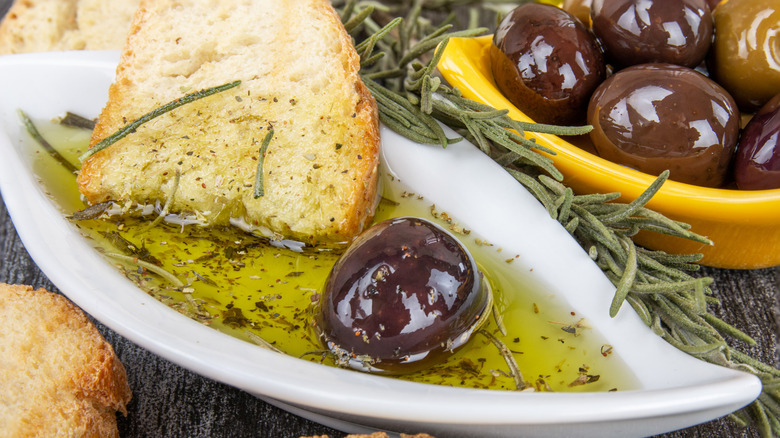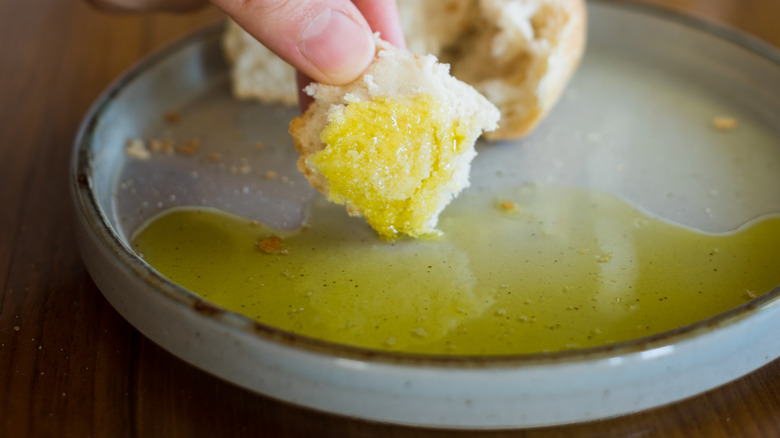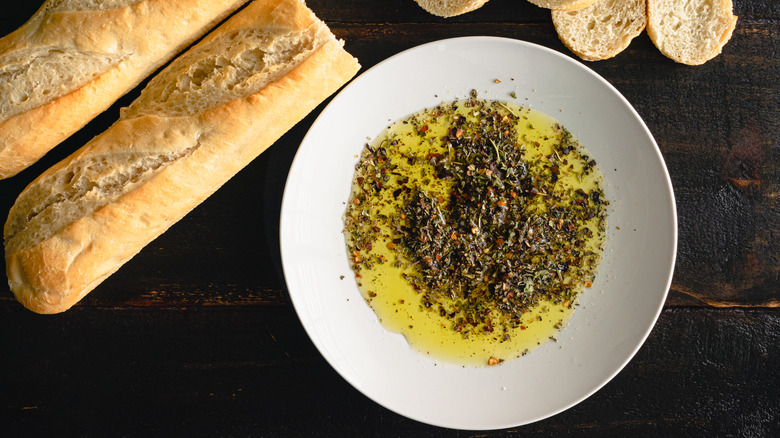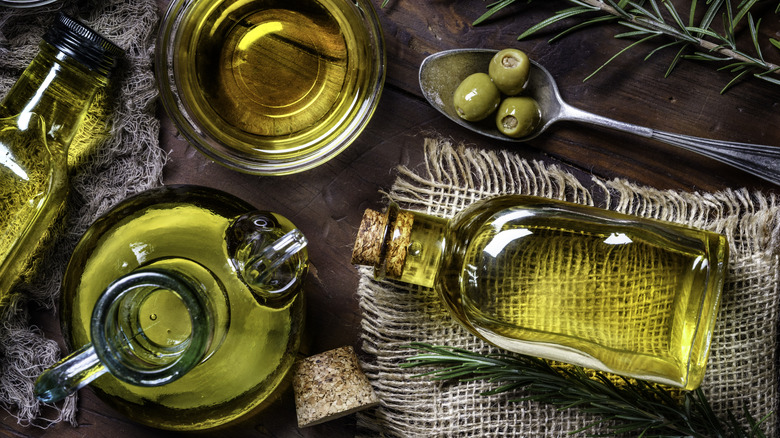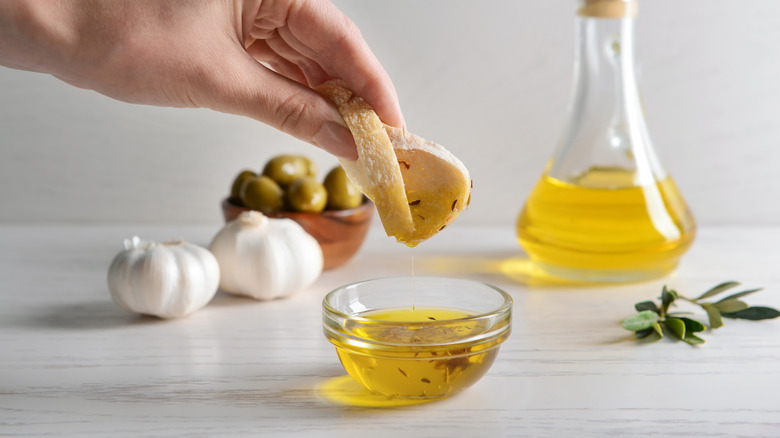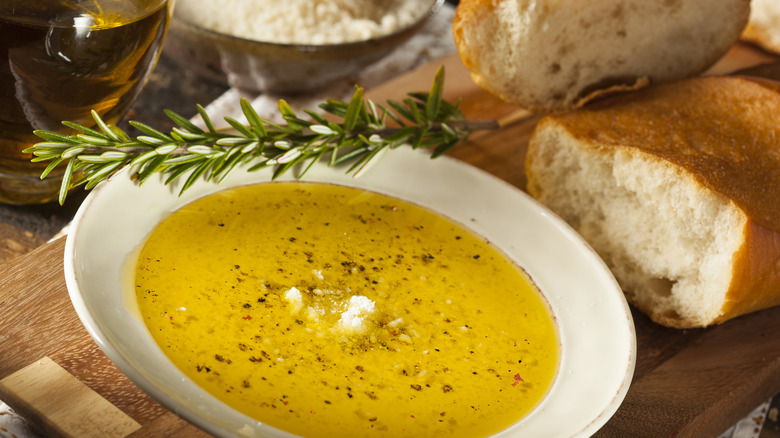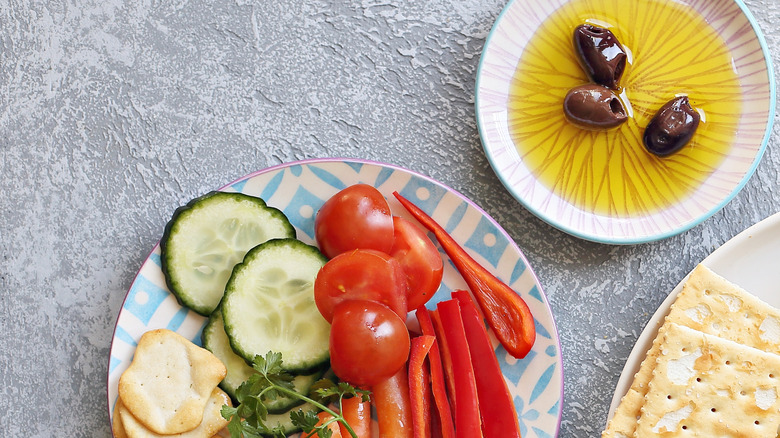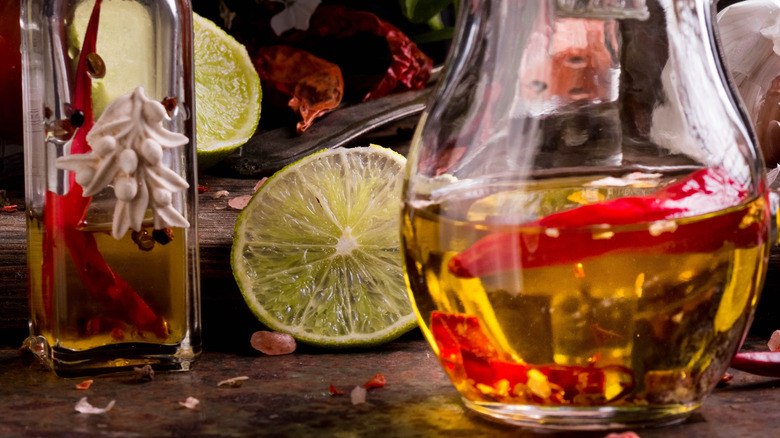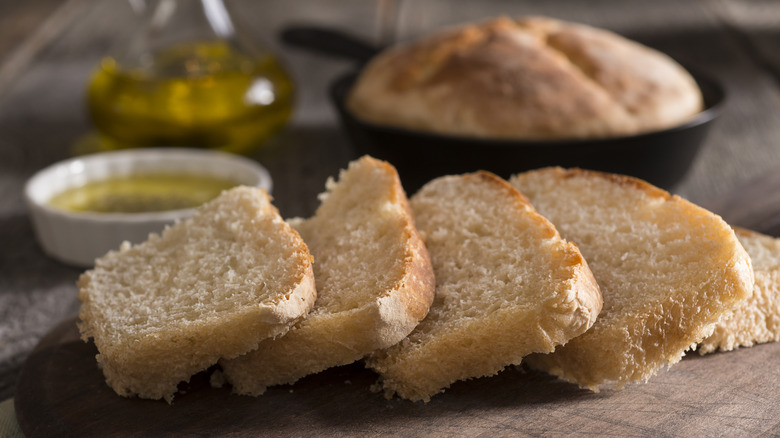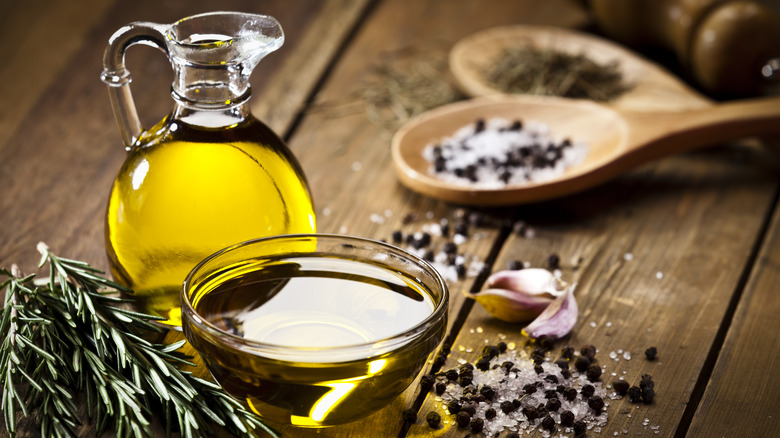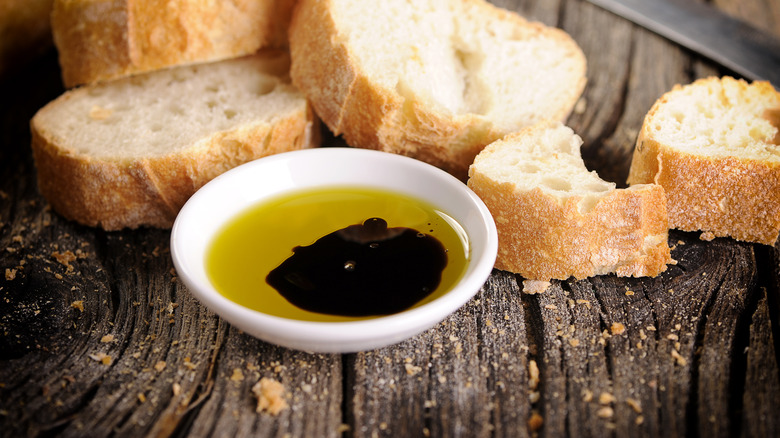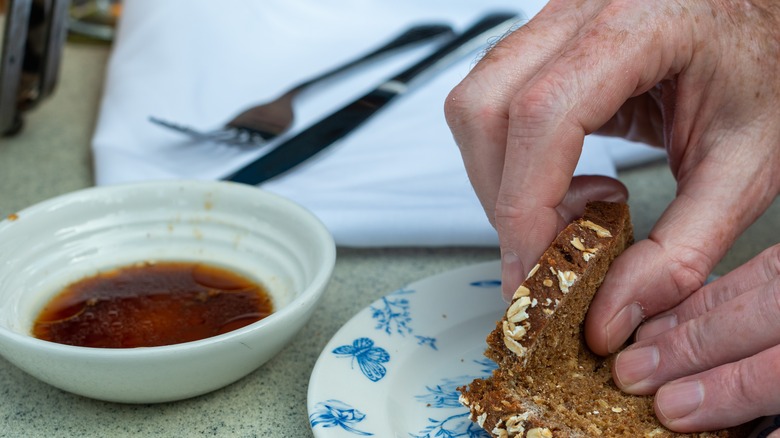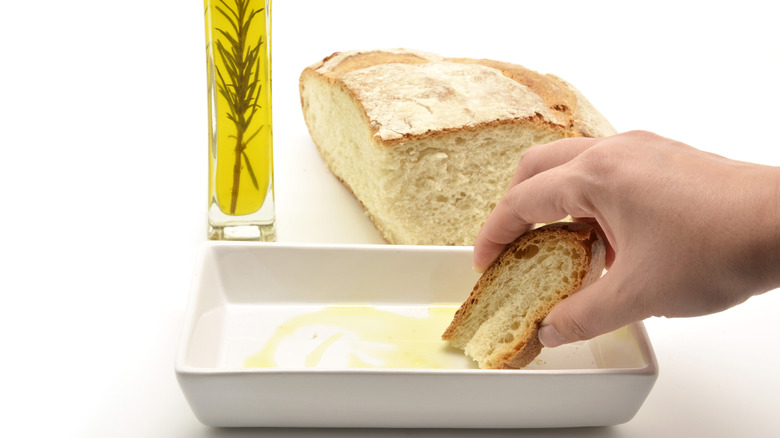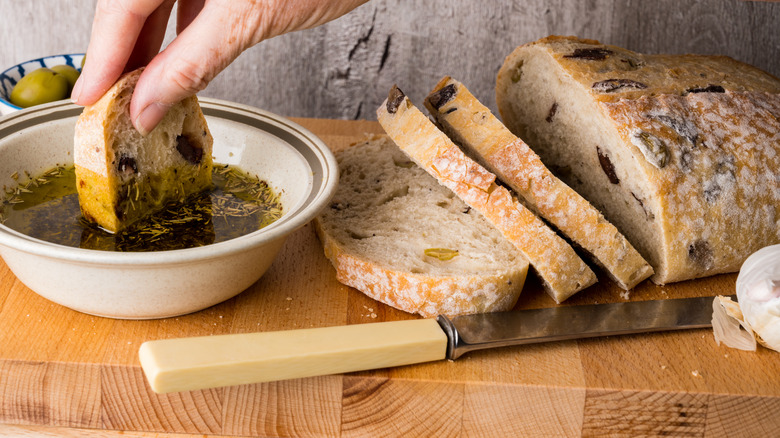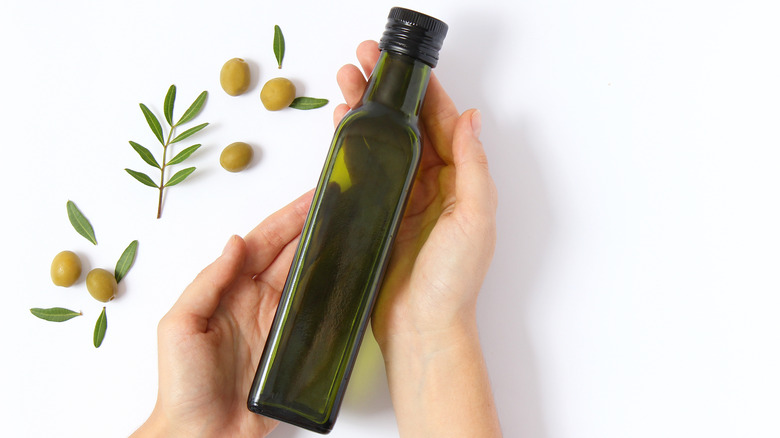Why Restaurant Bread Dipping Oil Is So Good & How To Properly Use It
What makes dining out so fantastic are all the little extras that make a meal out into a culinary experience. Sitting down, grabbing a hunk of bread, and dipping it into seasoned oil is a popular and flavorful little course. It's that mouthwatering combination of doughy bread and glistening oil that you can't get enough of. You probably don't serve it up at home too often though, especially when you're rustling up a mid-week dinner. It's super-easy to make, in theory, but somehow it always seems to taste way better when you're eating out.
What is it that chefs do to make this simple offering so unbelievably moreish? It's all about the ingredients, how it's served, and even how it's eaten. Check out why restaurant bread dipping oil is so good and how to properly use it. You might find out enough to turn this into one of your own signature servings at your next dinner party.
Use extra virgin olive oil
Restaurants use what's called finishing oil to serve with bread as a dip. This means that it's olive oil and is good enough to eat as it is. If the taste has a strong taste that's a little fruity and bitter then it's probably cold-pressed extra virgin olive oil, which is best for dipping in. While some restaurants load dipping oil with other ingredients, the simple combination of bread and olive oil can be incredible. Renowned for its healthy fats and antioxidant properties, olive oil is an ingredient that is intrinsic to the Mediterranean diet. It's a taste-good, feel-good food.
Olive oils come from different parts of the world, including the U.S., although if you're dining out on pasta or paella, then you may be dunking bread into Italian or Spanish olive oil. Greek olive oil is also popular. You might like grassy-tasting extra virgin olive oil or a dip with a nuttier taste. It can also taste fragrant or even a little buttery.
Add seasonings
One of the reasons restaurant bread dipping oil tastes so good is that it's given a flavorful boost with added seasonings. Herbs like rosemary, parsley, and oregano evoke an aromatic taste of Italy, and dried herbs will suffice. Extra seasonings like onion powder elevate the savory taste too. The U.S. Italian chain restaurant Bertucci's serves an olive oil dip to customers that's totally moreish. To recreate the taste add dried herbs, including basil. You can also use Italian seasoning and also add fresh herbs into the mix as well. Garlic powder elevates the taste, as do red pepper flakes.
Another restaurant chain that serves American-Italian cuisine is Carrabba's. The dipping oil served to hungry diners is wonderfully herby. Make it yourself by adding dried oregano, basil, and parsley to olive oil. Consider adding salt, onion powder, and garlic powder to lift the flavor. You can also add dried rosemary and red pepper, with salt and pepper. Stir the olive oil so that the seasonings are combined.
Try an infused olive oil
There are some incredible infused olive oils out there, with an assortment of flavors such as truffle, garlic, and lemon. Many of these are intended for adding to recipes to give dishes a little extra flavor. Some of these are made with olive oil and therefore are fine to use as dipping oils. However, in many restaurants, bread dipping oil is so good because chefs focus more on the quality of the oil and less on the flavorings. That's not to say that infused oils aren't up to par, as there are some gourmet versions. It's perhaps true though that a chef serving the very best extra virgin olive oil isn't going to be overly concerned about whether it's infused or not.
Some home cooks may make their own infusions. Olive oil with a sprig of rosemary in it can look attractive, but when it comes to infusing oil with a herby flavor you might want to use dried ones, as they are more robust. To create your own infused olive oil, simply heat the oil in a saucepan on low heat with whatever ingredients you like. Keep the oil warm for 10 to 15 minutes, but make sure it's not too hot. You definitely don't want it bubbling away. Strain, cool, and store the infused oil in a dry bottle.
Include fresh garlic
Years ago, bread and dripping was a wartime staple in Britain. Today, the same concept of doughy bread and flavorful fat is served in Italian and Spanish restaurants across the world. If you're wondering why restaurant bread dipping oil is so good, it's essentially because of the ingredients. Beyond using the best olive oil and bread, one important addition that transforms this simple dish has to be fresh garlic. The taste complements herbs and olive oil. If you're making this at home, and don't like the idea of eating minced raw garlic, then add roasted cloves instead for a sweeter taste. Or you could warm the oil with whole cloves added before removing them. You'll then have a homemade infused oil.
Since there are so few ingredients in the bread dipping oil, it's better to use fresh garlic rather than cloves from a jar. To let the garlic and the other ingredients work their flavorful magic it's best to make this around a half hour in advance. However, because of the fresh ingredients, the dipping oil will only be good for a few days. You could also try a combination of cloves cooked in olive oil with finely chopped raw garlic. Another option is to sauté chopped garlic. Each of these methods will bring out different notes to the garlic and pungency levels from subtle to powerful.
Add cheese
Are you a fan of soaking up restaurant-style olive oil dip with crusty bread? If so, you may have noticed the flavor often has a gorgeously salty tang. It may even taste a little creamy. Have you ever worked out why? It could well be because of a special added ingredient: cheese. Once you've made your base olive oil dip, all you need to do is grate in a little hard cheese. Italian varieties are especially wonderful such as Parmesan or Pecorino Romano. The taste is strong enough to make an impact without adding too much. You don't want to turn an oil dip into a grated cheese dip in oil, after all.
To make this yourself, stir together ½ a cup of olive oil and a tablespoon of a homemade mix of dry seasonings, Then add a tablespoon of grated cheese. Have you ever tried the cheesy dipping oil at the Italian-American restaurant chain Romano's Macaroni Grill? Make a copycat version by combining ½ teaspoon of Italian seasoning with ¼ cup of extra virgin olive oil and black pepper. Add two teaspoons of grated Parmesan. You're now ready to dip. If you want a cheesy, dairy-free olive oil dip then add nutritional yeast in place of Parmesan.
Dip other foods in oil
Restaurant bread dipping oil is so good that it's easy to dunk a big hunk of sourdough and find yourself full up. What if you're enjoying a light lunch, want to avoid carb-induced bloat, or want to leave room for a gloriously filling pasta dish? You might enjoy forgoing the bread and making the most of any other foods you can dip instead. There are plenty of European-style bistros that serve crudité with a creamy dip. However, whole or sliced raw veggies are delicious with a glistening coating of olive oil as well.
Sliced bell peppers, carrot batons, and cucumber slices are wonderfully crunchy. Tomatoes are a natural pairing with olive oil. Vegetables are not only nutritious, but they are gloriously colorful. Serve them on a sharing platter at a summer party or before an Italian family feast if you want to bring the goodness of olive oil dipping home. You could always combine bread with veggies, and a less doughy choice is crackers.
Extra ingredients will boost the taste
There's nothing wrong with a simple dish of olive oil, with a few seasonings, and a hunk of bread for dipping. And this is exactly what you'll get in a lot of restaurants. However, to elevate the dipping experience, a chef may want to add some other ingredients into the mix and create their own signature oil. If it's overloaded, then it'll become less like a dipping oil and more like a paste, so it's all about adding the right amount of ingredients.
If you're looking for ideas to try yourself, then why not add Mediterranean extras? Sundried tomatoes pair spectacularly with olive oil. So too — not surprisingly — do chopped-up olives. And if you're serving a dipping oil for a special occasion, or want to make it a little fancier, then what about dried fruit like cranberries? Adding fresh chilis of chili flakes can enhance the flavor by bringing in a mouth-tingling spicy touch. Grating citrus fruit zest into the oil also works fantastically, as does sumac, which promises a lemony punch.
Serve homemade bread
Making crusty Italian bread is so satisfying. There's something wonderfully therapeutic about baking bread and the aromas that fill the kitchen as the dough rises create a homey, warming atmosphere. And then there's the taste of warm bread to look forward to as well. One of the reasons why restaurant bread dipping oil is so good is because chefs often bake loaves fresh. Dining out and having great food made for you is such a treat, and a slice or two of homemade bread is the perfect way to start a delicious dining experience.
Whether it's plain rolls or an herby loaf, dipping pieces of bread into good olive oil is one of the best ways to enjoy the taste. In an Italian eatery, you may be served fresh focaccia, which is not only perfect for dunking, but it's made with olive oil and has a pillowy, chewy texture that makes it a popular choice.
Don't skip the salt and pepper
In the U.S., a lot of restaurants add different ingredients to olive oil to make a bread dip. In Spain, everyday eateries to high-end bistros serve this classic Mediterranean appetizer. And Europeans will happily serve this up at home as well, which makes sense since it's so easy to create and requires great ingredients but no culinary skill. There's nothing wrong with adding cheese, herbs, seasonings, and whatever else you might take inspiration from a restaurant experience you've had.
However, you don't need to be that fancy. It's often the case that a restaurant puts down on a table a bread basket, olive oil, and balsamic vinegar only. Whether you want to add balsamic or not is up to you, but a must is to season the oil with salt and pepper. This is the best way to enjoy bread and oil in the simplest way. Freshly ground black pepper looks and tastes better than powder, and ground sea salt enhances the flavor of the oil and the bread. It's best to season your own serving of olive oil. That way, you can keep adding to this as you pour out more of the oil and mop more of it up with the bread. Adjusting the taste is part of the appeal.
Add balsamic vinegar
In authentic European restaurants, olive oil for dipping bread isn't served alone. It always comes with a bottle of balsamic vinegar to add a little acidic tang. It would be a no-no for a chef or waiting staff to add the two together, as this is done at the table by the diner. The proportion of extra virgin olive oil and balsamic is a personal preference, but in general, you use more oil. You splash the vinegar in the oil rather than mix the two together. When you dip and drag a piece of bread in it will soak up both. You'll get the two flavors, but separately.
Like olive oil, the quality of balsamic vinegar can vary widely. If the chef at your chosen restaurant is all about using quality ingredients, the balsamic vinegar that's served with extra virgin olive oil will also be appetizing. Authentic balsamic vinegar is subject to a Protected Designation of Origin status; it has to be made from grapes that come from a certain region of Italy, and the aging process has to be at least 12 years. If a balsamic vinegar doesn't come from Moderna or Reggio Emilia, then it isn't the real stuff. Like sipping on fine wine, you'll taste the difference when dining at a restaurant serving the best of both oil and vinegar — not to mention great bread.
Serve before a meal
If you want to enjoy a restaurant-style meal at home with some Mediterranean dishes then an olive oil dip is a must. Dine out in Spain and as soon as you sit down you'll be presented with a basket of bread and at least one olive oil, if not a few choices. You'll usually find balsamic vinegar not too far away, too. It's also commonplace to be served a bowl of aioli, which is akin to a Spanish version of garlic mayonnaise. As you peruse the tapas menu and choose Spanish dishes, you can get your appetite worked up by munching down on bread and olive oil.
In the U.S. and in formal dining rooms in Europe and the U.K., dinner rolls are offered before entrees are served. However, this is different. Bread and dipping oil are a pre-appetizer or serving that arrives earlier. |You can also serve it as an appetizer. Sharing bread and the relaxed charm of dunking it in oil is a great way to make guests feel relaxed and create a homely atmosphere. It's a culinary ice-breaker at a party. If you're hosting a dinner in the sun or want to bring the flavors of Spain into your own dining room in the cold season, then this is the way to start. It is often loved by grown-ups and kids alike.
Put an oil bottle out and offer individual servings
To double-dip in a sharing dish is a dining etiquette no-no. Grabbing a piece of bread and slopping up olive oil isn't exactly a formal-style bite, but there are some rules. In Spain, bringing dishes of olive oil to the table would be unusual. In fact, a law was passed that effectively meant that olive oil had to be served in the original bottle with the right labeling. Diners like to know the details about different olive oils such as the brand, where it is from, and the quality. It's not so dissimilar to wanting to know which wine you're drinking.
Rather than dipping into a communal dish, diners pour oil onto a side plate or into little ceramic dishes. There are also special dipping dishes that have ripples over the surface. These raised parts allow you to dunk your bread and then slightly squeeze it against a side so not too much oil is soaked up. You don't want it dripping down and making a mess either. Of course, for a romantic dinner, you may not mind sharing a pretty dipping dish. Eat smaller pieces of bread so that you're not tempted to dip twice.
Pair with the right type of bread
Aside from the quality of the bread that you dip into olive oil, the type of loaf is also important. What you're looking for, and what good restaurant chefs understand, is the right balance between the taste and texture of the bread and the amount and flavor of the dipping oil. If the bread is too solid, it won't allow enough oil to penetrate and simply cling to the surface. Who knew the bread-dipping oil experience was such a culinary art form?
Olive bread is an obvious choice that's complementary in flavor and looks great. A loaf that's got a crusty edge is fine, and might make holding it easier. However, you do want the inside to have a certain amount of soft springiness to sop up the oil. Since dipping bread in oil is traditional in Italy, then country-style Italian bread like ciabatta is perfect. Rounds of a crusty baguette would be ideal if they're not too brittle. Sourdough bread is robust and promises a little tangy chewiness that complements olive oil well. Warm bread elevates the flavor. The heat makes the bread softer and the oil runnier. How long you dunk the bread for is important. A quick dip might not be enough, so let the bread mop up the oil for a few seconds.
Store dipping oil properly
Busy Italian and Spanish restaurants are going to get through a good amount of olive oil. They may use one oil for dipping and another for cooking. Either way, the oil isn't going to be hanging around, so you should be tasting oil that's fresh. A great chef is going to have the culinary contacts and know-how to choose the best brands if they want to impress diners. They also know how to store olive oil in the right way. And if you invest in a good bottle of extra virgin olive oil, then you'll want to do the same.
An unopened bottle may last a couple of years and one that's been used already may not be quite as good a few months later. You don't need to store olive oil in the fridge — in fact, a dry environment is best. What is necessary is to keep the oil away from sunlight. One sign you've found a good bottle is its color: Good quality olive oil often comes in a green bottle to protect against light.
